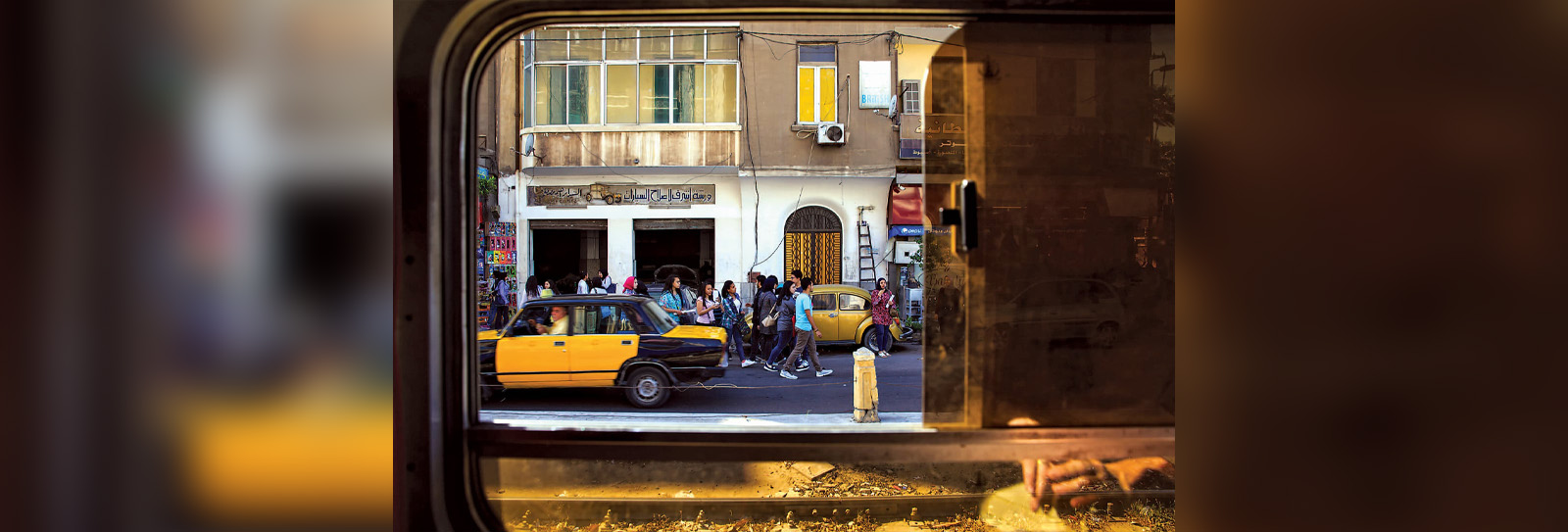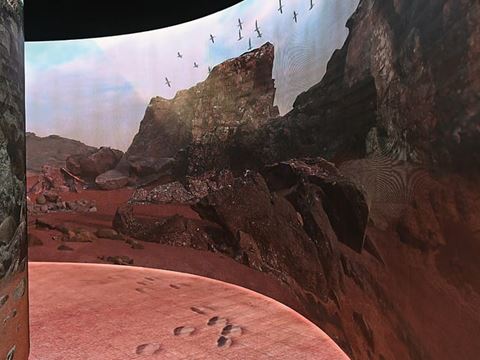
How to Discover Egypt From the Inside Out
Rather than just telling travelers where to go, the guidebook Egypt: Inside Out by Trevor Naylor offers an inside-out perspective that evokes the experience of being there, inviting readers to embrace an almost meditative travel discipline of slowing down to take in the details and complexities of Egypt, moment by moment.
8 min
Written by Trevor Williams Photographed by Doriana Dimitrova
As Trevor Naylor strode through the Square of Miracles in Pisa, Italy, a few years ago, taking in the white-domed splendor of the thousand-year-old cathedral on one side and its famous leaning tower on the other, he was struck by an all-too-familiar sight.
“I was one of a very small number of people actually looking at it. Everybody else stood with their back to the Leaning Tower of Pisa taking a selfie of themselves with that behind it. That was their experience,” says Naylor, a longtime publishing executive at the American University in Cairo Press and author of a pair of pictorial books about Egypt that aims to inspire travelers to take the opposite approach.
These oversights of orientation, driven by the speed and convenience of modern tourism, are what Naylor and photographer Doriana Dimitrova seek to remedy in their books, Cairo Inside Out (2017) and Egypt Inside Out (2020).
Egypt has long been a country where visitors fall into the rhythm of the tourist as they are toted from Giza’s pyramids to Cairo’s oldest mosques to Luxor’s temples on “15-day rattle-arounds.” But this approach comes at a cost, according to Naylor.
“That kind of tourism has always existed, and it exists now with the additional horror of people trying to capture it in their hands every minute and let everybody they know see they’re doing it 20 seconds later across the world,” Naylor says. “All of which reduces the amount of time you’re really spending looking at where you are.”
When exploring the country together for their books, the duo savors the ripe tension between Egypt’s unbroken antiquity and unbridled modernity. Their more recent book follows 2017’s Cairo Inside Out, a visual journey through a city Naylor has lived in twice and visited often since the 1980s, long before smartphones became the essential travel companion.
Both books invite readers to take a break from tour guides and schedules. Placed alongside Naylor’s prose, Dimitrova’s photos look outward, placing readers in the Anglo-Egyptian Bookshop in the heart of downtown Cairo one morning or on the Street of the Tentmakers, the only medieval covered market street left in the city, to take in the vibrant array of quilts, bags and other crafts, and get out of the sun.
“There were very few occasions when we took a photograph in a rush, and I think that shows through in the pictures,” Naylor says.
[The] inside-out perspective evokes the experience of being there, inviting readers to embrace an almost meditative travel discipline of slowing down to take in the details and complexities of Egypt, moment by moment.

That, in fact, is the point of their work. Rather than just telling travelers where to go, the inside-out perspective evokes the experience of being there, inviting readers to embrace an almost meditative travel discipline of slowing down to take in the details and complexities of Egypt, moment by moment.
“I just like them to feel what I’ve been feeling when I was there,” Dimitrova says. “With Egypt, you either love it or hate it. There is no other way. I really, really love it, and I do hope that people see my love and feel my love for it.”
Digital Distraction
By the time Egypt Inside Out was published in 2020, the COVID-19 pandemic had forced digital wanderlust to stand in for physical experience, but Naylor knew the book would help tourists when they came flooding back.
At the outset of the crisis, tourism accounted for about 12 percent of the country’s gross domestic product, according to the International Monetary Fund.
On one hand, the more visitors post their curated photos and videos online, the more tourists they inspire to visit, who in turn bring their dollars, pounds and yen. But neat online narratives can also lead to the impression that Egypt’s more-than-5,000-year history and cultural weight can be encapsulated in a few fleeting moments.
Ahmed Abd Al Fattah, who founded Look At Egypt Tours in 2006—the year before the iPhone debuted—has seen the rise of the “Insta-traveler” firsthand. “He comes to take some reels and photos—he will never even listen to when the pyramid was built—he wants to take some pictures and go,” Abd Al Fattah says.
Even less digitally engaged travelers are affected by online reviews that can muddle expectations, misleading them about the time it takes to really see the country. The result is that many of these reviews steal the curiosity and spontaneity from the 11.7 million tourists the Egyptian Ministry of Tourism and Antiquities counted in 2022, he contends. “So much information kills the excitement.”

Paper Anecdotes
Naylor counts himself grateful to have experienced Egypt for decades before the ubiquity of smartphones. Working in sales and marketing for the AUC Press, Naylor surrounded himself with books about the country for years before he decided to create his own.
He first teamed up with Dimitrova in the early 2010s to create A Roving Eye, which paired black-and-white portraits of everyday Egyptians with expressive colloquial Arabic phrases and sayings.
During their travels for that book, while finding refuge from the heat and hubbub, Naylor shared with Dimitrova an idea that had long been percolating. Years before, he’d been seated at the legendary Café Riche in Cairo, a spot dating back more than 100 years and frequented by novelist Naguib Mahfouz and other key Egyptian figures of the 20th century. As Naylor watched people pass by on Talaat Harb Street from the cafe’s dimly lit alcove, the concept had come to him.
The idea focused on documenting specific places they knew while also offering a sort of blueprint—not a travel guidebook, he says—that might inspire others to explore the city with a less regimented approach. “What was missing was a book about how people really see Cairo, looking out at it from a cool or hidden place,” Naylor says.
“What was missing was a book about how people really see Cairo, looking out at it from a cool or hidden place.”
—Trevor Naylor

He also wanted to preserve and document something of the Cairo he’d come to know. An old hand in the city, Naylor had found himself returning to El Horreya Cafe (literally meaning the freedom cafe) at the Windsor Hotel, which has little changed in interior or furnishings since it served as the British Officers Club during World War I. He came to treasure spending time in these places that seemed bathed in the grandeur of an earlier age. But development brings change, and as Cairo has evolved, the future of the feluccas plying the Nile, the houseboats along its banks and august institutions like the Egyptian Rowing Club has grown more uncertain.
Based on their previous travels together and her own years of living in Egypt from 2009 to 2016, Dimitrova understood why Naylor wanted to capture the character of such places before they disappeared.
“We figured out that we are a good team in that way—he didn’t really have to explain it to me,” Dimitrova says.
Upon its publication, Cairo Inside Out spurred inquiries from readers and bookshop owners about an expanded version focused on Egypt, not just on the city of Cairo. Egypt Inside Out was ready three years later, taking the reader on a picturesque journey northward along the Nile, from the Nubian culture and archeological richness of Aswan to the temples at Luxor and all the way to Cairo and Alexandria along the coast.
“I wanted to keep it a surprise for me, to see what my visceral reaction would be, being in this moment, enjoying it.”
—photographer Doriana Dimitrova
While Naylor conducted research on each destination included in the books, Dimitrova waited for Egypt’s variable light and shadows to inspire her.
“I wanted to keep it a surprise for me, to see what my visceral reaction would be, being in this moment, enjoying it,” Dimitrova says. “I take pictures more from emotion rather than thinking about the mechanics of photography.”
With both books, Dimitrova and Naylor pored over their captions, distilling descriptions to give even the casual reader experiential insight into shots of ancient temples, centuries-old mosques and street scenes captured from the windows of a moving train.
“Every moment of photography is a human moment; it’s not a static, painted picture to go into a travel brochure,” Naylor says.
That’s the message Naylor hopes people take away from both books, especially as there’s every indication that Egypt will continue to be packed with visitors. With the new Grand Egyptian Museum set to operate in 2024, and a recent spate of celebrity visits and pent-up pandemic demand, Egypt’s tourism wave could swell even beyond the 46 percent annual increase it saw in 2022, according to Egypt’s Ministry of Tourism and Antiquities. Travelers should be ready for crowds—and to embrace the unexpected.

“(Egypt) can force you to slow down because it’s not an easy place to travel; things don’t happen quickly or on time. There are hurdles along the way, and you have to go with it and see the charm in that—or get frustrated,” Naylor says.
Going with a group may bring convenience, but it also might pull travelers toward a fast-food experience of a place that demands to be savored, Naylor says.
To avoid this pitfall, Naylor challenges travelers, in Egypt and beyond, to embrace the moments when things don’t go according to plan as opportunities to take a different approach.
“For everything that is fast, there is also a slow equivalent,” Naylor says.
You may also be interested in...

Ithra Explores Hijrah in Islam and Prophet Muhammad
History
Arts
Avoiding main roads due to threats to his life, in 622 CE the Prophet Muhammad and his followers escaped north from Makkah to Madinah by riding through the rugged western Arabian Peninsula along path whose precise contours have been traced only recently. Known as the Hijrah, or migration, their eight-day journey became the beginning of the Islamic calendar, and this spring, the exhibition "Hijrah: In the Footsteps of the Prophet," at Ithra in Dhahran, Saudi Arabia, explored the journey itself and its memories-as-story to expand understandings of what the Hijrah has meant both for Muslims and the rest of a the world. "This is a story that addresses universal human themes," says co-curator Idries Trevathan.
Orion Through a 3D-Printed Telescope
Arts
With his homemade telescope, Astrophotographer Zubuyer Kaolin brings the Orion Nebula close to home..jpg?cx=0.5&cy=0.5&cw=480&ch=360)
Photo Captures Kuwaiti Port Market in the 1990s
History
Arts
After the war in 1991, Kuwait faced a demand for consumer goods. In response, a popular market sprang up, selling merchandise transported by traditional wooden ships. Eager to replace household items that had been looted, people flocked to the new market and found everything from flowerpots, kitchen items and electronics to furniture, dry goods and fresh produce.